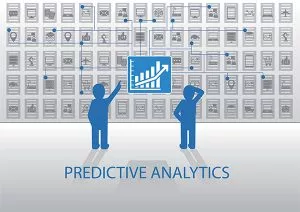We’re in the midst of a data revolution. Each day we create 2.5 quintillion bytes of data that helps feed a market set to be worth over $203 billion dollar by 2020. Data is the currency of our digital world, and businesses of all sizes are finding ways to use artificial intelligence (AI) and machine learning to cash in on the insights their raw information can provide. A whopping 70 percent of enterprises plan to roll out artificial intelligence within the next few months, and a big portion of them are using cutting edge tools like these to see the future. Say hello to the world of predictive data analytics.  Predictive analytics bring together a menagerie of techniques including data mining, predictive modeling, AI, and machine learning to analyze patterns and trends in data to determine plausible future outcomes. The more information available to feed a predictive model, the more accurate it becomes. Think of it like a weather report on your local news. The more information a meteorologist has about past and current weather patterns, the more accurately he or she can forecast. The trouble is that with more data comes greater difficulty in analyzing it, and humans can only do so much. When AI and machine learning can handle the heavy lift connecting data points, it becomes much easier to create accurate future forecasts using vast amounts of data.
Predictive analytics bring together a menagerie of techniques including data mining, predictive modeling, AI, and machine learning to analyze patterns and trends in data to determine plausible future outcomes. The more information available to feed a predictive model, the more accurate it becomes. Think of it like a weather report on your local news. The more information a meteorologist has about past and current weather patterns, the more accurately he or she can forecast. The trouble is that with more data comes greater difficulty in analyzing it, and humans can only do so much. When AI and machine learning can handle the heavy lift connecting data points, it becomes much easier to create accurate future forecasts using vast amounts of data.  If you’re hoping to predict the future for your business, think about your goals and the challenges you’re trying to overcome and look for a partner that can help. While it’s easy to go with big names like IBM and Microsoft, there are many niche players that understand your industry and what it takes for you to succeed. Bigger doesn’t mean better and smaller, more focused startups can help you see amazing success from your predictive analytics program.
If you’re hoping to predict the future for your business, think about your goals and the challenges you’re trying to overcome and look for a partner that can help. While it’s easy to go with big names like IBM and Microsoft, there are many niche players that understand your industry and what it takes for you to succeed. Bigger doesn’t mean better and smaller, more focused startups can help you see amazing success from your predictive analytics program.
What Are Predictive Data Analytics?

What Are the Applications?
Predictive analytics are changing every industry and offering insights that range from market forecasting to competitive investigation to customer needs analysis. Here’s a quick look at how industries are using predictive analytics right now.- Agriculture – Predictive analytics can help with longer term weather forecasting to help farmers plan for dry years or years with larger insect populations. These tools let them monitor acres of farmland and help them address things that will affect yield before they become a problem (low moisture, lack of fertilizer, etc.).
- Credit Scoring – Perhaps the most common example of predictive analytics, credit scoring uses models that incorporate various data (applications, credit history, etc.) to rank individuals based on how likely they are to make loan payments in the future.
- Insurance – Before an insurance company writes a policy, they must understand all the risks involved. For a home, this includes the home’s previous claim history, the history of the homeowner, the likelihood of larger weather events, natural disasters, and more. Insurance companies are using predictive data analytics to gather this information and analyze it on a large scale so they can more reliably predict risk and write policies that give homeowners adequate coverage with premiums that account for all the hazards.
- SMBs – Analytics aren’t just for the big dogs anymore. Small-to-medium-sized businesses in industries ranging from technology to retail are using data analytics to help them grow. With analytics tools, they can streamline processes, maximize employee productivity, develop and analyze marketing strategies, and predict customer behaviors and needs.
Who Are the Key Players?
There are lots of predictive analytics providers and many are small, niche players geared toward specific industries or aspects of a business (e.g. productivity or customer experience). Some big names working in the business intelligence and analytics field include:Conclusion

You May Also Like
- Uncategorized
5 Steps to Building an Effective Ransomware-Free Data Protection Strategy
July 5th, 2021 - Business Continuity Uncategorized
Arcserve & StorageCraft: The New Business Continuity Leader
February 24th, 2021